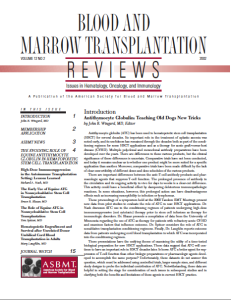 Antithymocyte Globulin: Teaching Old Dogs New Tricks
Antithymocyte Globulin: Teaching Old Dogs New Tricks
by John R. Wingard, MD, Editor
Antithymocyte globulin (ATG) has been used in hematopoietic stem cell transplantation (HSCT) for several decades. Its important role in the treatment of aplastic anemia was noted early, and its usefulness has remained through the decades both as part of the conditioning regimen for some HSCT applications and as a therapy for acute graft-versus-host disease (GVHD). Multiple polyclonal and monoclonal antibody preparations have been developed over the years. There are differences in these various products, but the clinical significance of these differences is uncertain. Comparative trials have not been conducted, and today it remains unclear as to whether one product might be more suited for a specific application than another. Moreover, comparative trials have been made difficult by the lack of clear convertibility of different doses and dose schedules of the various products. There are important differences between the anti-T-cell antibody products and pharmacologic agents that suppress T-cell function. The prolonged presence of antibody in the circulation and its ongoing activity in vivo for days to weeks is a clear-cut difference. This activity could have a beneficial effect by dampening deleterious immunopathologic reactions. In some situations, however, this prolonged action can have disadvantageous effects such as increasing susceptibility to infection or lymphomas.
These proceedings of a symposium held at the 2002 Tandem BMT Meetings present new data from pilot studies to evaluate the role of ATG in new HSCT applications. Dr. Nash discusses ATG use in the conditioning regimen of patients undergoing high-dose immunosuppressive (not cytotoxic) therapy prior to stem cell infusions as therapy for immunologic disorders. Dr. Blazar presents a compilation of data from the University of Minnesota regarding the use of ATG as therapy for patients with refractory acute GVHD and examines factors that influence outcome. Dr. Spitzer considers the role of ATG in nonablative transplantation conditioning regimens. Finally, Dr. Laughlin reports outcome data from patients undergoing cord blood transplantation in which ATG was incorporated into the conditioning regimen. These presentations have the unifying theme of examining the utility of a time-tested biological preparation for new HSCT applications. These data suggest that ATG will continue to have an important role in HSCT decades later. Is horse ATG a better agent for suppression of T-cell function than other biologic preparations or pharmacologic agents developed to accomplish the same purpose? Unfortunately, these datasets do not answer this question, which must be addressed using controlled trials, larger sample sizes, and different study designs to probe the individual contribution of ATG. Notwithstanding, these data are helpful in setting the stage for consideration of such issues in subsequent studies and in clarifying both the benefits and limitations of these agents in current HSCT practice.
Download a PDF version of the full issue.
